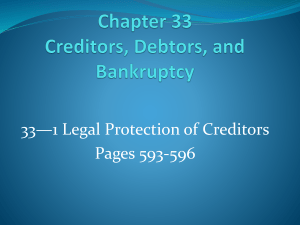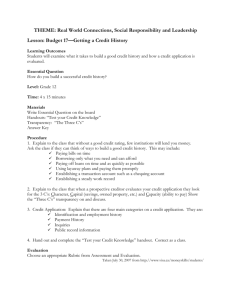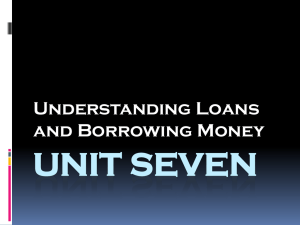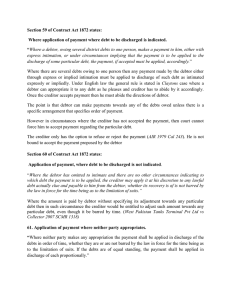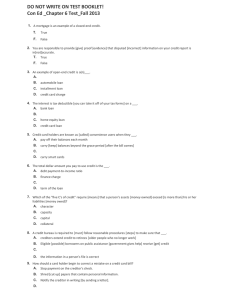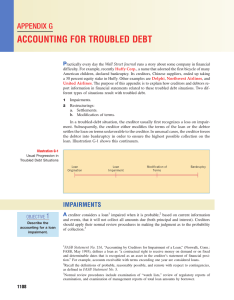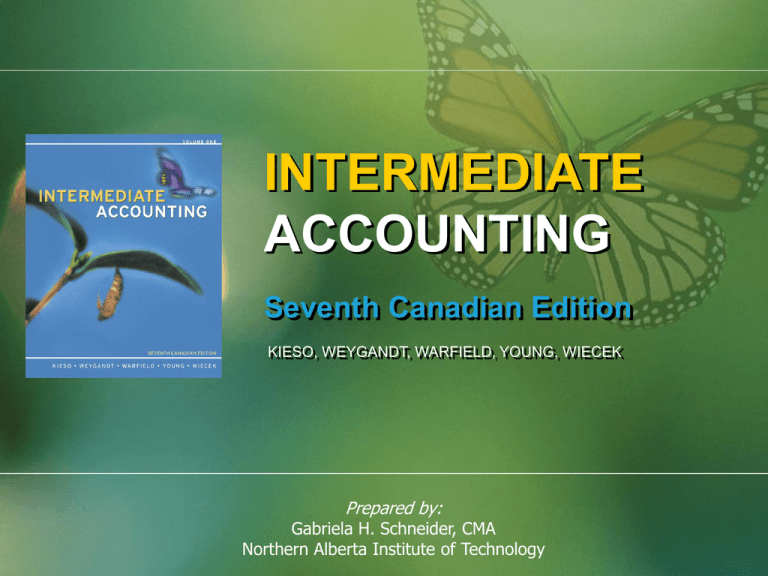
INTERMEDIATE
ACCOUNTING
Seventh Canadian Edition
KIESO, WEYGANDT, WARFIELD, YOUNG, WIECEK
Prepared by:
Gabriela H. Schneider, CMA
Northern Alberta Institute of Technology
Appendix 15A
Troubled Debt
Learning Objectives
9.
Account for impairments on notes and loans
receivable
10. Distinguish between and account for debt
restructurings resulting in extinguishment
versus debt continuation
Accounting Issues
• In troubled debt cases, two important
issues emerge:
• When should a loss be recognized?
• When it is likely a loss will occur, and
• When the loss can be measured
• What is the amount of loss to be
recognized?
Troubled Debt: Key Terms
Troubled debt
Impairment
Restructuring
Probable loss:
Creditor unable
to collect principal
and interest.
Creditor grants a
concession to
debtor due to
debtor’s financial
difficulties.
Troubled Debt: Key Terms
Restructuring
Creditor grants a concession to debtor
due to debtor’s financial difficulties.
Settlement
Debtor transfers equity
interest or
assets to creditor
Modification of Terms
1. Reduction of principal
2. Reduction of interest rate
3. Extension of maturity date
4. Reduction of accrued interest
Progression of Troubled Debt
Loan
Origination
Creditor
recognizes
loss
Loan
Impairment
Restructuring
Debtor may
recognize
gain/Creditor
refines estimate
of loss
Foreclosure
/Bankruptcy
If all else fails –
to ensure some
level of collection
Impairment of Loans/Notes
Receivable
• Loss measured at estimated realizable
value
– Expected future cash flows discounted at
the historical interest rate
• When future cash flows not
determinable loss measured at:
– FV of any security attached to loan, or
– Market price of loan (if any)
Impairments—Example
Given:
December 31, 2004: $500,000 5-year note issued
to Community Bank
Effective interest rate: 10%
Entries to record the issuance of the note
Impairments—Example
Debtor
Cash
310,460
Discount on Notes Payable 189,540
Notes Payable
500,000
Creditor
Notes Receivable
500,000
Discount on Notes Receivable 189,540
Cash
310,460
Impairments—Example
• Loan becomes impaired December
2006
• Future cash flows expected: $300,000
• Amount of loss to be recorded based on
expected future cash flows
• Loss equal to:
Carrying value of loan
less
PV of expected future cash flows
Impairments—Example
PV of expected future cash flows:
Expected future cash flow: $300,000
Discounted at: 10%
Number of discount periods: 3
Present value = $225,396
Carrying value of loan
At December 31, 2004
Dec. 31/05 Accrued Interest (310,460 x 10%)
Dec. 31/06 Accrued Interest (341,506 x 10%)
Carrying Value
$310,460
31,046
341,506
34,151
$375,657
Impairments—Example
Loss on Impairment:
Carrying value of loan less
$375,657
PV of expected future cash flows = 225,396
$150,261
Entry to record the loss:
Bad Debt Expense
Allowance for Doubtful Accounts
150,261
150,261
Interest and Amortization
After Impairment
Date
Cash
Received
0%
Interest
Revenue
(10%)
Discount
Amortized
Carrying
Amount of
Note
$225,396
12/31/06
12/31/07
$0
$22,540
$22,540
247,936
12/31/08
0
24,794
24,794
272,730
12/31/09
0
27,273
27,273
300,000
$0
$74,607
$74,607
Total
Interest and Amortization
After Impairment
December 31, 2007 entry:
Discount on Note
22,540
Interest Income
22,540
December 31, 2009 entry:
Allowance for Doubtful
Cash
Discount on Note
Note Receivable
150,261
300,000
49,739
500,000
Troubled Debt Restructurings
•
•
When a creditor grants a favorable
concession to a debtor
Two basic types of transactions
1. Settlement of debt at less than carrying
value
2. Continuation of debt with modification of
terms
Gain or Loss: Debtor and
Creditor Settlement
Debtor
• Gain = excess of
carrying amount of
payable over fair
value of assets
transferred to creditor
• The gain is not
extraordinary
• Recognize loss or
gain on disposition of
non-cash assets
Creditor
• Loss = excess of
loan receivable over
fair value of assets
received from
debtor
• The loss is ordinary
and is charged to
Allowance for
Doubtful Accounts
Modification of Terms
• No gain or loss recognized
• New effective interest rate must be
found
– Carrying value of old debt equates to cash
flows of newly arranged debt
• First step required
– Determine if a settlement has occurred or a
modification of terms
Modification of Terms—Example
Given:
Debt terms are modified
Carrying value of debt: $10,500,000
Total future cash flows: $11,880,000
Annual payments:
$ 720,000
The effective interest rate must be such that the PV of
$11,880,000 is $10,500,000
In this case (using a financial calculator and n = 4,
interest rate = 3.466%)
COPYRIGHT
Copyright © 2005 John Wiley & Sons Canada, Ltd.
All rights reserved. Reproduction or translation of
this work beyond that permitted by Access Copyright
(The Canadian Copyright Licensing Agency) is
unlawful. Requests for further information should be
addressed to the Permissions Department, John
Wiley & Sons Canada, Ltd. The purchaser may make
back-up copies for his or her own use only and not
for distribution or resale. The author and the
publisher assume no responsibility for errors,
omissions, or damages caused by the use of these
programs or from the use of the information
contained herein.

